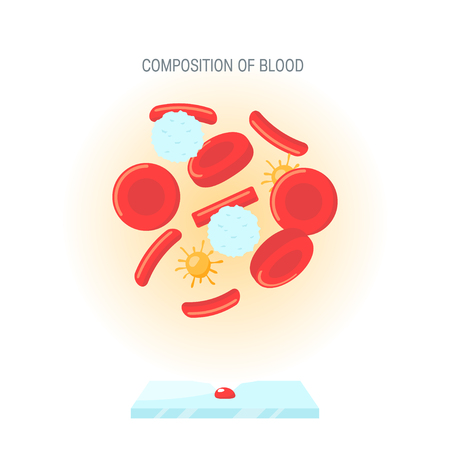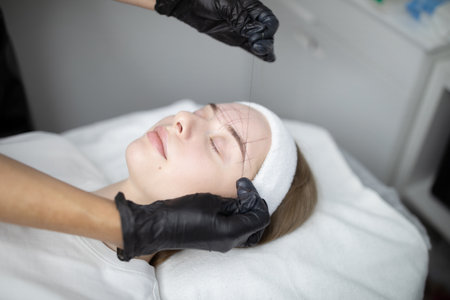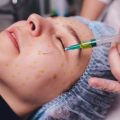Introduction to Laser Treatments in Fitzpatrick Skin Types IV-VI
The Fitzpatrick skin type classification is a widely adopted dermatological tool, categorising skin based on its response to ultraviolet light. Types IV, V, and VI represent individuals with olive to dark brown and black skin tones, which are increasingly prevalent within the UK’s diverse population. According to recent demographic data, communities of African, Caribbean, South Asian, and mixed heritage backgrounds constitute a significant and growing proportion of the British population. This demographic trend has been matched by rising interest in aesthetic and therapeutic laser procedures tailored to darker skin types. While advancements in laser technology have enabled safer treatment options for these groups, it remains critical for practitioners and patients alike to understand the unique challenges posed by higher melanin content. As demand for laser therapies continues to rise among those with Fitzpatrick types IV-VI, a comprehensive understanding of potential complications is essential for optimal patient outcomes and safety.
2. Pigmentary Alterations: Hyperpigmentation and Hypopigmentation
Laser treatments in Fitzpatrick skin types IV–VI are notably complicated by pigmentary alterations, with post-inflammatory hyperpigmentation (PIH) and hypopigmentation being the most frequently observed issues. These complications are predominantly driven by the unique melanin biology present in darker phototypes, where a higher baseline melanin content increases both the risk and severity of pigment changes following cutaneous injury or inflammation induced by laser energy.
Post-Inflammatory Hyperpigmentation (PIH)
PIH is a particularly prevalent complication in individuals with Fitzpatrick types IV–VI, manifesting as darkened patches at treatment sites. This occurs when laser-induced inflammation prompts melanocytes to upregulate melanin production, leading to uneven pigmentation. UK-based clinical audits have reported PIH rates ranging from 25% to 40% in patients with darker skin undergoing aesthetic laser procedures, compared to less than 10% in lighter skin types. The risk is further accentuated with ablative and non-ablative fractional lasers, as well as Q-switched modalities commonly used for pigment and tattoo removal.
Mechanisms Behind PIH
- Increased baseline epidermal melanin absorbs more laser energy, heightening inflammatory response
- Laser-induced injury stimulates cytokine release, activating melanogenesis pathways
- Suboptimal device settings (e.g., wavelength, pulse duration) exacerbate the risk of excessive pigment production
Hypopigmentation
Conversely, hypopigmentation—where treated areas become lighter than surrounding skin—results from melanocyte destruction or dysfunction post-laser. Although less common than PIH, it can be especially distressing and persistent for patients with darker phototypes due to the high contrast against their natural skin tone. Clinical surveys in the UK indicate that hypopigmentation affects approximately 5–15% of Fitzpatrick IV–VI patients after aggressive resurfacing or repeated high-fluence treatments.
Mechanisms Behind Hypopigmentation
- Direct thermal injury leading to partial or complete loss of functional melanocytes
- Cumulative damage from repeated sessions without adequate recovery periods
- Use of inappropriate laser parameters or insufficient cooling during procedures
Incidence of Pigmentary Alterations in Fitzpatrick Types IV–VI: UK Data Summary
| Complication Type | Incidence Rate (%) | Main Associated Laser Modalities |
|---|---|---|
| Post-Inflammatory Hyperpigmentation (PIH) | 25–40% | Ablative Fractional Lasers, Q-Switched Lasers |
| Hypopigmentation | 5–15% | Aggressive Resurfacing Lasers, Repeated Sessions |
The high incidence of pigmentary alterations in Fitzpatrick IV–VI skin underscores the need for tailored protocols and culturally competent patient education within UK dermatology and aesthetic practices. Proper pre-procedure assessment and post-treatment care are pivotal for minimising these risks and optimising clinical outcomes.

3. Scarring and Textural Changes
Laser treatments in individuals with Fitzpatrick skin types IV–VI carry a heightened risk of adverse outcomes related to scarring and textural alterations. Among these, keloid and hypertrophic scarring are particularly notable complications due to the higher melanocyte activity and distinct dermal response patterns characteristic of darker skin phototypes.
Keloid and Hypertrophic Scarring Risks
Patients with higher Fitzpatrick skin types are inherently more susceptible to abnormal wound healing, which can result in keloid or hypertrophic scar formation following laser procedures. Keloids typically extend beyond the original injury site, while hypertrophic scars remain within the boundaries but present as raised, firm lesions. The pathophysiology involves excessive fibroblast proliferation and collagen deposition—mechanisms that are more reactive in richly pigmented skin. Certain laser modalities, such as ablative devices or those delivering high energy densities, further increase these risks if not meticulously calibrated for darker skin tones.
Typical Presentation in Fitzpatrick IV–VI Patients
Clinically, these scars manifest as thickened, often hyperpigmented plaques that may be pruritic or tender. In Fitzpatrick IV–VI patients, the visibility of such scarring is accentuated by contrast against the surrounding skin. Furthermore, altered texture—such as atrophy or lichenification—may accompany pigmentary changes, compounding patient distress and impacting overall cosmetic outcomes.
Cultural Attitudes Toward Visible Scarring in the UK
In the UK’s diverse population, visible scarring carries social and psychological implications, particularly among communities where skin appearance is closely linked to self-esteem and cultural identity. There is an increasing emphasis on preventative counselling and informed consent within NHS and private clinics, recognising that visible scars can affect social interactions, employment prospects, and mental health. Consequently, British practitioners are encouraged to adopt a culturally sensitive approach: prioritising minimally invasive techniques, thorough pre-procedural assessment, and bespoke aftercare advice tailored for patients with higher Fitzpatrick skin types.
4. Paradoxical Hair Stimulation
Paradoxical hair stimulation, also known as paradoxical hypertrichosis, is a notable complication observed in Fitzpatrick skin types IV–VI undergoing laser treatments, particularly for hair removal. Instead of reducing unwanted hair, some patients experience an unexpected increase in hair density and thickness in or adjacent to the treated areas. This phenomenon is especially prevalent among individuals of African, South Asian, and Caribbean heritage residing in the UK, whose skin and hair characteristics differ significantly from lighter skin phototypes.
Understanding the Mechanism
The exact mechanism behind paradoxical hair stimulation remains under investigation, but several factors have been implicated:
- Subtherapeutic energy settings: Insufficient laser fluence may not fully destroy hair follicles and can instead stimulate dormant follicles into active growth phases.
- Hormonal influences: Areas such as the face are hormonally sensitive, making them more susceptible to unintended stimulation post-treatment.
- Genetic predisposition: Genetic background common in African, South Asian, and Caribbean populations may influence follicular response to laser energy.
Commonly Affected Facial Regions
Paradoxical stimulation is most frequently reported in facial regions where fine vellus hairs are present. The table below outlines facial sites at higher risk for this complication in darker skin tones:
| Facial Area | Description | Population Most Affected |
|---|---|---|
| Jawline & Chin | Dense terminal and vellus hairs; hormonally sensitive area | African & South Asian women |
| Upper Lip | Fine vellus hairs with risk of conversion to terminal hairs | South Asian & Caribbean women |
| Sideburns/Cheeks | Areas often targeted for aesthetic refinement | African & South Asian individuals |
| Neck (submental) | Sensitive to both hormonal and mechanical triggers | African & Caribbean men and women |
Clinical Considerations for the UK Context
The growing multicultural population across cities like London, Birmingham, and Manchester has led to increased demand for laser treatments among individuals with Fitzpatrick IV–VI skin types. Clinicians must recognise that paradoxical hair growth is not merely a cosmetic nuisance but a source of significant distress that can undermine patient trust in advanced dermatological procedures.
Mitigation Strategies
- Appropriate device selection: Utilising long-pulsed Nd:YAG lasers minimises risk due to deeper penetration and less melanin absorption at the epidermal level.
- Patient counselling: Prior to treatment, practitioners should discuss the possibility of paradoxical stimulation, especially when treating facial areas prone to this response.
- Treatment protocol adjustment: Avoiding low-fluence protocols and ensuring adequate intervals between sessions help reduce incidence rates.
- Cultural competence: Understanding patient expectations within the context of UK’s diverse ethnic communities can lead to better patient outcomes and satisfaction.
This insight into paradoxical hair stimulation highlights the necessity for evidence-based approaches and culturally tailored care pathways when providing laser treatments to those with darker skin phototypes in the UK.
5. Thermal Injury and Delayed Healing
Burn Risk and Blistering in Fitzpatrick Skin Types IV-VI
One of the most significant complications associated with laser treatments in Fitzpatrick skin types IV-VI is the heightened risk of thermal injury, including burns and blistering. Melanin-rich skin absorbs greater amounts of laser energy due to its higher pigment concentration, increasing susceptibility to unintended thermal damage. The compromised epidermal barrier following laser exposure can result in localised burns or blisters, often more severe than those observed in lighter skin tones. This outcome not only poses immediate discomfort but also elevates the risk of subsequent hyperpigmentation or scarring.
Prolonged Erythema and Healing Dynamics
Delayed healing is another common complication for individuals with darker skin types undergoing laser procedures. Prolonged erythema—persistent redness or inflammation—can last weeks longer compared to fairer skin, owing to a combination of increased dermal reactivity and slower turnover rates. In some cases, this extended period of inflammation may lead to post-inflammatory pigment alterations, complicating the recovery process and potentially requiring additional intervention.
Contributing Factors Unique to Melanin-Rich Skin
The fundamental role of melanin as a chromophore means it not only protects against ultraviolet radiation but also inadvertently absorbs therapeutic wavelengths during laser procedures. As a result, even minor miscalculations in fluence or wavelength can precipitate excessive thermal load in the skin, leading to injury. Additionally, the structural characteristics of darker skin—such as thicker dermis and denser collagen networks—may further modulate wound healing responses, sometimes resulting in abnormal scarring or keloid formation.
Environmental Influences: The British Climate
The British climate introduces additional variables affecting laser treatment outcomes in patients with Fitzpatrick IV-VI skin types. The typically cool and damp weather may contribute positively by reducing transepidermal water loss post-procedure; however, sudden shifts towards warmer or sunnier conditions can increase sensitivity and risk for complications if adequate photoprotection is not maintained. Seasonal variations also influence vitamin D synthesis and general skin health, which can subtly impact the pace of recovery after thermal injury.
Clinical Implications and Best Practices
Given these risks, practitioners in the UK must employ tailored approaches when treating melanin-rich skin with lasers. This includes meticulous pre-treatment assessment, conservative energy settings, judicious device selection, and clear patient education regarding environmental care post-treatment. Such measures are essential for minimising burn risk, promoting optimal healing, and aligning with the unique needs presented by both Fitzpatrick IV-VI skin types and the variable British environment.
6. Prevention and Management Strategies
Review of Best Practices for Fitzpatrick Skin Types IV-VI
Effective prevention and management of complications from laser treatments in individuals with Fitzpatrick skin types IV-VI requires a bespoke approach, taking into account the unique risks associated with higher melanin content. As laser technology continues to advance, practitioners in the UK must prioritise patient safety by adhering to evidence-based strategies specifically tailored for darker skin phototypes.
Appropriate Device Selection
The cornerstone of safe laser practice in darker skin tones begins with selecting the correct device. Long-pulsed Nd:YAG lasers (1064 nm) are generally considered the gold standard due to their deeper penetration and reduced affinity for epidermal melanin, thereby minimising the risk of post-inflammatory hyperpigmentation (PIH) and burns. Alexandrite and diode lasers require heightened caution and expert parameter adjustment when used on skin types IV-VI. Fractional non-ablative devices may also be preferable for certain indications, as they limit epidermal disruption.
Parameter Modification
To further mitigate risk, practitioners should adjust fluence, pulse duration, and spot size based on both the device and patient’s individual skin characteristics. Lower energy settings, longer pulse durations, and adequate cooling are critical measures to reduce thermal injury. Test patches performed on inconspicuous areas can help gauge skin response prior to full treatment. Detailed documentation of all parameters used is essential for tracking outcomes and refining protocols over time.
Aftercare Advice Tailored to UK Patients
Post-treatment care plays a pivotal role in preventing adverse events such as PIH or scarring. Patients should be advised to avoid sun exposure and use broad-spectrum sunscreens with high SPF, especially during periods of increased UV risk in the UK spring and summer months. Emollients may aid barrier recovery, while topical agents like mild corticosteroids or pigment suppressors can be prescribed when early signs of inflammation or hyperpigmentation arise. Practitioners should provide clear written instructions and schedule timely follow-up appointments to monitor healing.
Summary of Key Recommendations
In summary, best practice for laser treatments in Fitzpatrick skin types IV-VI within the UK context hinges on: thorough pre-treatment assessment; choosing devices with established safety profiles for darker phototypes; careful adjustment of parameters; diligent aftercare education; and ongoing practitioner training aligned with current guidelines. By integrating these strategies into clinical routines, practitioners can enhance both safety and efficacy, ultimately improving patient satisfaction and outcomes.

